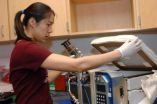(Press-News.org) A new study finds high folate intake is associated with a reduced risk of colorectal cancer, a finding consistent with the findings of most previous epidemiologic studies. The study is reassuring, as previous recent evidence has suggested that consumption of very high levels of folate through supplements and from folate-fortified diet may increase risk of some cancers. Nonetheless, the potential importance of folate in colorectal cancer prevention remains in question because at least one other study found folate supplementation had no effect on recurrence of colorectal adenomas, precursors to colorectal cancer.
The study appears in Gastroenterology, and is the first to look at the association of folate with colorectal cancer risk with follow-up entirely after the mandatory fortification of the U.S. diet with folate. It also is the first to distinguish between the forms of folate found naturally in forms and folic acid, the form used for fortification and in supplements.
A research team led by Victoria Stevens, Ph.D., strategic director of laboratory services at the American Cancer Society, investigated the association between folate intake and colorectal cancer among 99,523 participants in the Cancer Prevention Study II Nutrition Cohort. A total of 1,023 participants were diagnosed with colorectal cancer between 1999 and 2007, a period entirely after folate fortification began. Neither higher nor lower risk was observed during the first two years of follow-up (1999 to 2001), but during 2002 to 2007, high folate intake was associated with a reduced risk of colorectal cancer.
"While folate fortification has been a public health success in reducing the risk of neural tube defects, the potential for an increase risk of cancer has been legitimate," said Dr. Stevens. "Our study population included many participants who consumed these very high levels of folate and we found no increased risk of colorectal cancer in these individuals. Nonetheless, one randomized clinical trial failed to show folate supplementation reduced the risk of adenomas, the non-cancerous colon polyps that can become cancerous, so we need to continue to investigate the influence of folate on cancer development in high risk populations as well as potential differences in the action of natural and synthetic form of this vitamin."
###
Article: High Levels of Folate From Supplements and Fortification Are Not Associated With Increased Risk of Colorectal Cancer; Victoria L. Stevens, Marjorie L. McCullough, Juzhong Sun, Eric J. Jacobs, Peter T. Campbell, Susan M. Gapstur; doi:10.1053/j.gastro.2011.04.004
Link to abstract: http://www.gastrojournal.org/article/S0016-5085(11)00475-6/abstract
Folate intake may reduce colorectal cancer risk
2011-07-07
ELSE PRESS RELEASES FROM THIS DATE:
AgriLife Research study: Cool-season grasses more profitable than warm-season grasses
2011-07-07
VERNON – Access to swine effluent or waste water can help a producer grow more grass. But a Texas AgriLife Researcher says the grass is "greener" economically if it is a cool-season rather than a warm-season variety.
Dr. Seong Park, AgriLife Research economist in Vernon, said while the warm-season grasses appear to have a greater growth boost with swine effluent application, the cool-season grasses have marketing advantages that make it a more viable economic option for producers in the Oklahoma Panhandle and Southern Plains.
Park recently had the results of his study ...
Distract yourself or think it over? 2 ways to deal with negative emotions
2011-07-07
A big part of coping with life is having a flexible reaction to the ups and downs. Now, a study which will be published in an upcoming issue of Psychological Science, a journal of the Association for Psychological Science, finds that people choose to respond differently depending on how intense an emotion is. When confronted with high-intensity negative emotions, they tend to choose to turn their attention away, but with something lower-intensity, they tend to think it over and neutralize the feeling that way.
Emotions are useful—for example, fear tells your body to get ...
How hot did Earth get in the past? Team of scientists uncovers new information
2011-07-07
The question seems simple enough: What happens to the Earth's temperature when atmospheric carbon dioxide levels increase? The answer is elusive. However, clues are hidden in the fossil record. A new study by researchers from Syracuse and Yale universities provides a much clearer picture of the Earth's temperature approximately 50 million years ago when CO2 concentrations were higher than today. The results may shed light on what to expect in the future if CO2 levels keep rising.
The study, which for the first time compared multiple geochemical and temperature proxies ...
The impact of candidates' statements about climate change on electoral success
2011-07-07
Candidates gain votes by taking a "green" position on climate change -- endorsing the existence of warming, human causation, and the need for taking action to address it, according to a new study of U.S. adults.
Among citizens who are Democrats and Independents, a hypothetical U.S. Senate candidate gained votes by making a green statement on climate change and lost votes by making a not-green statement, compared to making no statement on climate. Among citizens who are Republicans, the candidate's vote share was unaffected by taking a green position or a not-green position, ...
Energy express focus issue: Optics in LEDs for lighting
2011-07-07
WASHINGTON, July 5 – Light-emitting diodes (LEDs) have been changing the way we see the world since the 1960s. Their usage in everyday life is pervasive and continues to increase thanks to the cutting-edge research being done in the field of optics. To highlight breakthroughs in LEDs, the editors of Energy Express, a bi-monthly supplement to Optics Express, the open-access journal of the Optical Society (OSA), today published a special Focus Issue on Optics in LEDs for Lighting. The issue is organized and edited by Guest Editors Jae-Hyun Ryou and Russell Dupuis of the Georgia ...
Researchers characterize biomechanics of ovarian cells according to phenotype at stages of cancer
2011-07-07
Using ovarian surface epithelial cells from mice, researchers from Virginia Tech have released findings from a study that they believe will help in cancer risk assessment, cancer diagnosis, and treatment efficiency in a technical journal: Nanomedicine http://www.nanomedjournal.com/article/S1549-9634%2811%2900184-5/abstract
By studying the viscoelastic properties of the ovarian cells of mice, they were able to identify differences between early stages of ovarian cancer and more advanced and aggressive phenotypes.
Their studies showed a mouse's ovarian cells are stiffer ...
National Zoo Welcomes Whooping Crane
2011-07-07
After an 88-year-long hiatus North America's tallest bird, the statuesque whooping crane (Grus americana), is once again on exhibit at the Bird House at the Smithsonian's National Zoological Park. An 11-year-old male whooping crane named Rocky left Homosassa Springs State Park in Florida and is now on exhibit in the nation's capital. Whooping cranes are one of only two crane species native to the United States. There are only eight other zoos in the U.S. which exhibit these birds.
"It is an honor for the National Zoo to once again exhibit this magnificent species," said ...
Twin study shows lifestyle, diet can significantly influence course of macular degeneration
2011-07-07
BOSTON -- Eating a diet high in vitamin D, as well as the nutrients betaine and methionine, might help reduce the risk of macular degeneration, according to new research conducted by Tufts Medical Center scientists. Their study of identical twins from the US World War II Twin Registry also found that the more a person smoked, the higher their risk of developing macular degeneration. The study, "Smoking, Dietary Betaine, Methionine, and Vitamin D in Monozygotic Twins with Discordant Macular Degeneration: Epigenetic Implications" published in the journal Ophthalmology on ...
Researchers engineer functioning small intestine in laboratory experiments
2011-07-07
LOS ANGELES (July 5, 2011) – Researchers at The Saban Research Institute of Children's Hospital Los Angeles have successfully created a tissue-engineered small intestine in mice that replicates the intestinal structures of natural intestine—a necessary first step toward someday applying this regenerative medicine technique to humans.
The study led by Tracy C. Grikscheit, MD —"A Multicellular Approach Forms a Significant Amount of Tissue-Engineered Small Intestine in the Mouse"— has been published in the July issue of Tissue Engineering Part A, a premier biomedical journal. ...
Final space shuttle to carry 5 CU-Boulder-built payloads
2011-07-07
The University of Colorado Boulder is involved with five different space science payloads ranging from antibody tests that may lead to new bone-loss treatments to an experiment to improve vaccine effectiveness for combating salmonella when Atlantis thunders skyward July 8 on the last of NASA's 135 space shuttle missions.
One experiment, sponsored by the global pharmaceutical companies Amgen and UCB, will test an antibody to sclerostin -- a protein that has a negative effect on bone formation, mass and strength -- on lab mice flying on the shuttle. Researchers on the project ...



